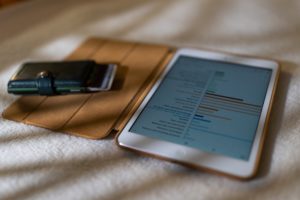Learning how to manage your checking account is definitely one of those boring tasks that come with adulthood. But keeping on top of it is key to taking charge of your finances. Not only will you avoid any nasty overdraft fees, you’ll also get a clearer sense of your spending habits, so you can constantly make better choices.
There are basically three kinds of tasks it takes to manage your checking: those you do only once, those you do daily, and those you do monthly.
Tasks to Manage your Checking Account
One Time Setup Tasks
It might take you thirty minutes or more to knock out all these to-dos, but you only have to do them once.
1. Sign up for online banking
Making sure you can access your accounts online is a must, so don’t put off the task of getting your online access up and running.
2. Sign up for account alerts
Most banks let you set notification preferences so you can get a text or email alert for important account activity, like when your balance dips below a certain threshold, when you receive an automatic deposit, or when your account is overdrawn.
3. Tie your checking to your savings account
If you know you’re at risk for the occasional overdraft, see if your bank offers account linking. Then, if your checking balance is insufficient, your bank will automatically move money from your savings account to cover the transaction.
4. Sign up for direct deposit
Save yourself some hassle by setting up direct deposit for any income you can.
5. Get an online banking app
You’re more likely to keep track of your finances if you can do it from anywhere, so download your bank’s app to your smartphone.
6. Get a check book register app
Since most people have a mix of paper checks and debit card transactions, your best bet is to use an online register that lets you keep track of both in the same place.
Daily Tasks
1. Balance your check book register
Whether you’re keeping track online or on paper, make sure you’re entering any paper checks you’ve written and that your debit card transactions are showing up. These days, most check card transactions are debited to your account immediately. However, some online purchases may take up to 48 hours to show up, so check your register and add a transaction manually if it hasn’t appeared yet.
2. Don’t forget about automatic withdrawals you have set up
For the sake of convenience, many people have some of their bills set to come out of checking automatically. Make sure you get them in your register at the right time.
Deposit any paper checks you receive
To keep your cash flow flowing, deposit any paper checks you receive right away. Many banks offer the option to deposit checks via mobile app. Just follow the prompts to enter the payment details and snap a photo of both sides of the check. No trip to your bank branch required.
Monthly Tasks
If you’re keeping on top of your daily checkbook balancing, there’s very little you’ll have to do at the end of the month.
Reconcile with your bank statement
Quickly go through and make sure your transaction list matches the bank’s. If you find any discrepancies, call the bank to get it figured out.
Reorder paper checks
If you’re still using paper checks for some purchases, make sure you reorder them before you completely run out. That’s it! With some thoughtful preparation and a few minutes of attention each day, you’ll be managing your checking account like a boss.
What’s Next?
That’s it! With some thoughtful preparation and a few minutes of attention each day, you’ll be managing your checking account like a boss.






